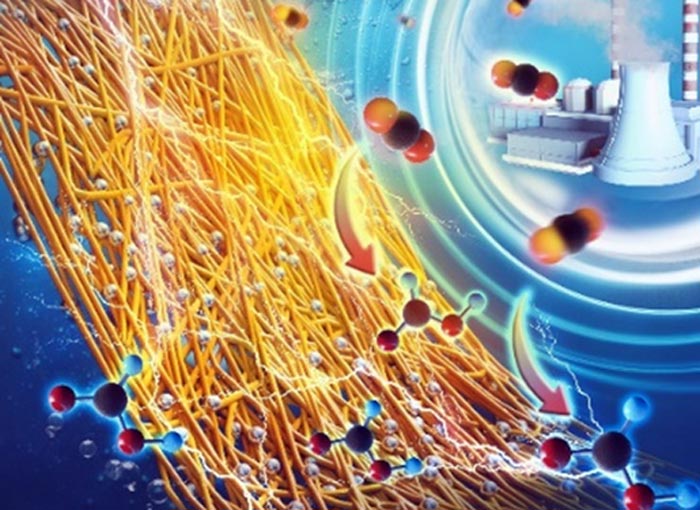Carbon nanofiber encapsulated Bi nanoparticles

Electrochemical CO2 conversion is one of the most promising strategies to achieve carbon neutrality. Carbon nanofiber encapsulated bismuth nanoparticles were synthesized through electrospinning-pyrolysis techniques, which exhibited excellent formate selectivity and ultrahigh mass activity, providing a potential alternative for the large-scale preparation of electrocatalysts and industrialized application in electroreduction CO2 to formate.
Credit: Chinese Journal of Catalysis
… for electroreduction CO2 toward formate.
Electrochemical CO2 reduction reaction (CO2RR) to value-added chemical feedstocks has been deemed as an intriguing way to achieve carbon neutrality while alleviating fossil fuel depletion. Moreover, among all the reduction products, formate reveals the most promising prospect for large-scale industrial applications due to the high selectivity and uncomplicated two-electron transfer process. Notably, Bi-based materials have trigged significant attention in conversion CO2 to formate on account of their low toxicity, low price, and environmental benignity. However, low mass activity and instability impede extremely the development of Bi-based electrocatalysts.
Recently, a research team led by Prof. Chuanxin He from Shenzhen University and University of Science and Technology of China, reported a bismuth nanoparticle electrocatalyst encapsulated by carbon fibers (denoted as Bi/CNFs-900) boosting CO2 electroreduction to formate. This sample was fabricated through a facile and economical electrospinning-pyrolysis procedure. The results were published in Chinese Journal of Catalysis (https://doi.org/10.1016/S1872-2067(22)64177-9).
What is noteworthy is that the aggregation of the metal nanoparticles might diminish the available active sites and consequently reduce the actual utilization of metal composition. The researchers introduced carbon nanofibers as the support, which can confine the Bi metal aggregation during the pyrolysis and catalysis process, exposing more active sites while improving the stability of catalysts. The as-prepared electrocatalyst, Bi/CNFs-900, demonstrated outstanding selectivity to formate (> 90%) in a neutral electrolyte over a broad potential range with a high partial current density of -232.2 mA cm-2 at -1.20 V vs. RHE, which made it possible to achieve the industrialization of formate production. In addition, an overwhelming mass activity of -1.6 A mgBi-1 and yield rate of 29.8 mol h-1 cm-2 g-1 were achieved by Bi/CNFs-900, which were roughly 7 times higher than that obtained with Bi BPs.
Through further mechanism investigation, the authors concluded that the electrostatic interaction between bismuth and surrounding carbon reduced interfacial charge transfer resistance, which could promote the rapid delivery of electrons, boosting the electrocatalysis CO2 activity. DFT calculations also indicated that the formation of *OCHO intermediate was the rate-determining step of formate production. Bi/CNFs-900 exhibited the lower *OCHO adsorption energy in comparison with the Bi BPs, which was more favorable to convert CO2 toward formate. In brief, the uniform dispersion of ultrasmall Bi nanoparticles, more abundant exposure of active sites, and faster interfacial charge transfer endow Bi/CNFs-900 excellent CO2RR performance. Last but not least, the electrospinning technique is a prospective candidate for the large-scale preparation of electrocatalysts, facile and economical.
About the Journal
Chinese Journal of Catalysis is co-sponsored by Dalian Institute of Chemical Physics, Chinese Academy of Sciences and Chinese Chemical Society, and it is currently published by Elsevier group. This monthly journal publishes in English timely contributions of original and rigorously reviewed manuscripts covering all areas of catalysis. The journal publishes Reviews, Accounts, Communications, Articles, Highlights, Perspectives, and Viewpoints of highly scientific values that help understanding and defining of new concepts in both fundamental issues and practical applications of catalysis. Chinese Journal of Catalysis ranks among the top two journals in Applied Chemistry with a current SCI impact factor of 12.92. The Editors-in-Chief are Profs. Can Li and Tao Zhang.
At Elsevier http://www.journals.elsevier.com/chinese-journal-of-catalysis
Manuscript submission https://mc03.manuscriptcentral.com/cjcatal
Media Contact
Fan He
Dalian Institute of Chemical Physics, Chinese Academy Sciences
hef197@dicp.ac.cn
Office: 86-411-843-79240
All latest news from the category: Life Sciences and Chemistry
Articles and reports from the Life Sciences and chemistry area deal with applied and basic research into modern biology, chemistry and human medicine.
Valuable information can be found on a range of life sciences fields including bacteriology, biochemistry, bionics, bioinformatics, biophysics, biotechnology, genetics, geobotany, human biology, marine biology, microbiology, molecular biology, cellular biology, zoology, bioinorganic chemistry, microchemistry and environmental chemistry.
Newest articles

Largest magnetic anisotropy of a molecule measured at BESSY II
At the Berlin synchrotron radiation source BESSY II, the largest magnetic anisotropy of a single molecule ever measured experimentally has been determined. The larger this anisotropy is, the better a…

Breaking boundaries: Researchers isolate quantum coherence in classical light systems
LSU quantum researchers uncover hidden quantum behaviors within classical light, which could make quantum technologies robust. Understanding the boundary between classical and quantum physics has long been a central question…

MRI-first strategy for prostate cancer detection proves to be safe
Active monitoring is a sufficiently safe option when prostate MRI findings are negative. There are several strategies for the early detection of prostate cancer. The first step is often a…



